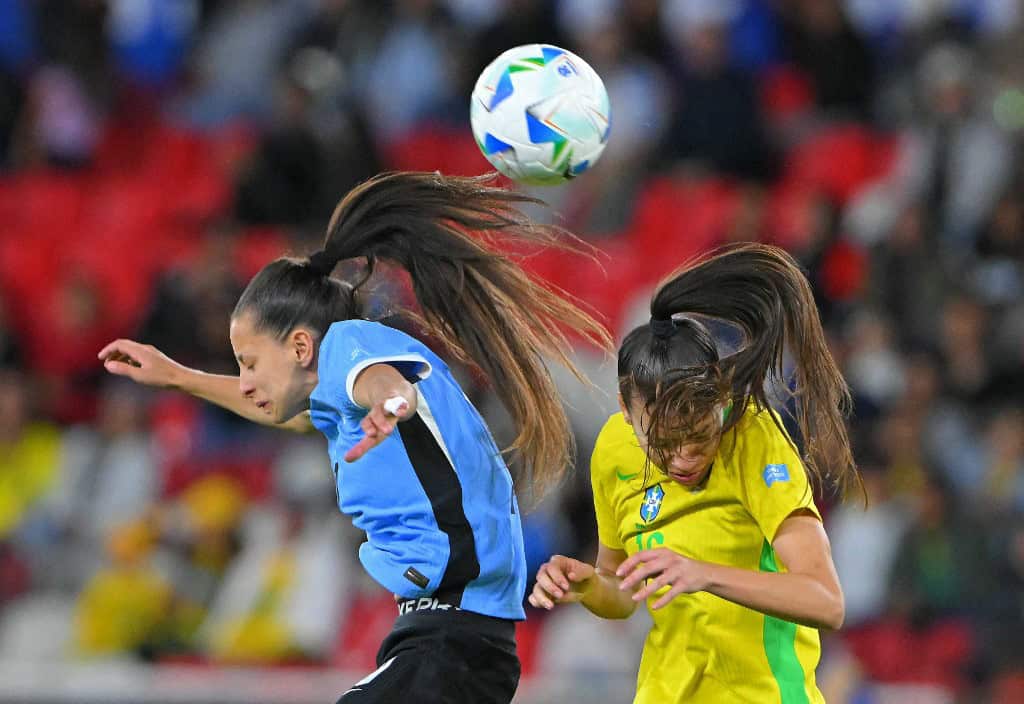“I didn’t see Pelé, but I saw Marta,” read a sign held by a small but loyal group of fans who followed the ten South American teams competing in the 10th Women’s Copa América, where Brazil and Colombia emerged as the top contenders.
Although small in number, Brazil’s supporters were among the most spirited throughout the 2025 tournament in Ecuador. Standing for the full 90 minutes, they beat their drums and tambourines to cheer on the Seleção.
Colombia and Venezuela also drew crowds, largely from their migrant communities in Ecuador. Still, most stadiums remained nearly empty.
CONMEBOL was asked for attendance figures, but the organization said it would release a report after Saturday’s closing match. Fans shared their reasons for following women’s soccer.
Follow Their Example
Milena Benavides traveled overnight from Ipiales in southern Colombia to Quito to watch the final and inspire her teenage daughter to pursue a professional future in soccer. She brought along a group of young girls from Deportivo Neymar, a small local team in her hometown.
Wearing Colombia’s alternate jersey, Benavides came to the stadium with her own dream: to see Real Madrid star Linda Caicedo, whom she proudly calls “berraca” (fearless). “It fills you with pride to see these women inspiring other girls to follow their example,” said Benavides.
At 38, she hopes that watching the match between Colombia and Brazil will make her daughter Ángela “fall even more in love with soccer and continue chasing this beautiful career.”
For the Queen
Roberto Sabela, a 43-year-old Brazilian, arrived in Ecuador with his wife when the tournament began on July 11. He admits he follows women’s soccer for its quality. “For us, there’s no difference between men’s and women’s soccer. We support them both the same,” he said, surrounded by fellow Brazilians.
He regrets the tournament’s lack of visibility. “There needs to be more support from CONMEBOL and FIFA. Too many people don’t even know Copa América is happening,” he said. Like Benavides, Sabela came to Quito hoping to see the queen of women’s soccer: Marta, who has announced this will be her last edition of South America’s premier tournament.
“Marta is our female Pelé,” he said, crossing his fingers that she’ll bring her magic one last time at the 2027 Women’s World Cup in Brazil.
To Motivate Her
Sandra Amaya’s family, from about 120 km south of Quito, attended their second match of the tournament on Saturday. Their motivation was her 12-year-old daughter, who dreams of becoming a professional soccer player and joining a foreign club.
Amaya admits she barely knows which teams reached the final, but her daughter can list the players by name. “We have a girl who loves this sport, and sharing this with her is everything… it’s also a way to push her, to motivate her,” Amaya said.
Host nation Ecuador drew the biggest crowds, although it was eliminated in the group stage. The local federation estimated that about 6,000 fans attended one of La Tricolor’s matches. That figure pales compared to the 623,000 spectators recorded throughout the 2025 Women’s Euro.
Machismo Still Lingers
César Guerrero traveled from Santo Domingo de los Tsáchilas, about three hours away, to watch Linda Caicedo, Colombia’s star, and feel a bit closer to his homeland.
The 58-year-old shopkeeper lamented that the stadium wasn’t full, especially for a final. “These players are proving there should be no gender difference in the way we support a team,” he said.
“There’s still a lack of pride, a lack of connection to the Colombian team. I think there’s still a lot of machismo,” he added.
Despite the lower interest compared to other tournaments, Guerrero remains hopeful. “I want to see things change so that in future tournaments, there’s more support,” he emphasized.






